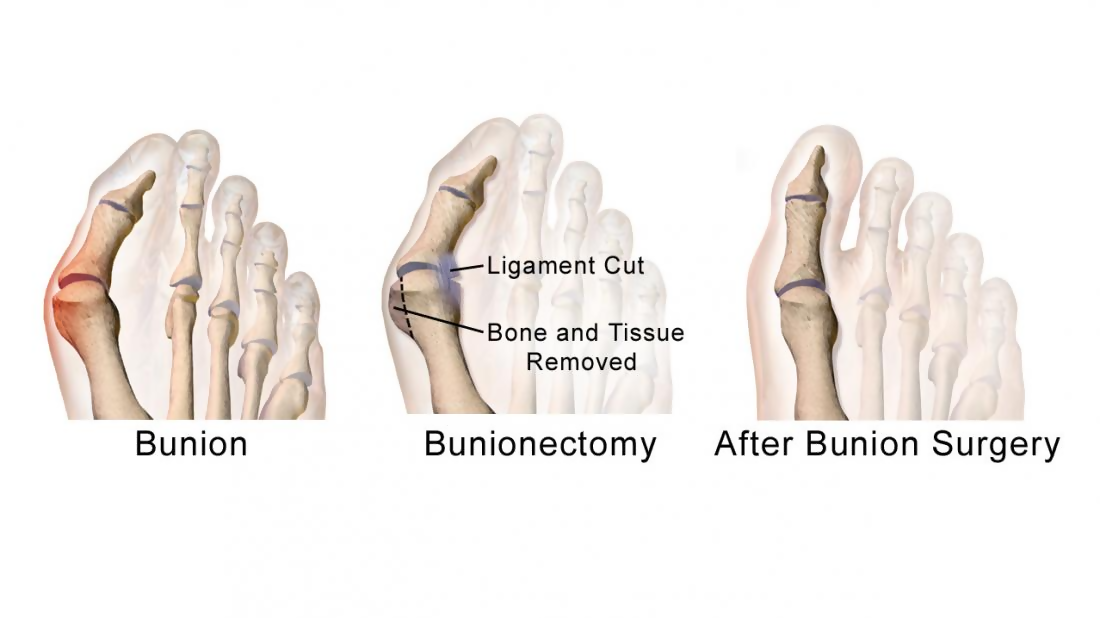 Also referred to as Hallux valgus, it is a painful bump which is bony and it develops in the big toe joint inside the foot. Besides, one can suffer from a tailor’s bunion which forms alongside the fifth metatarsal alongside the little toe. The development is slow, gradually changing the structure of the bones and the pressure causes the toes to lean towards each other.
Also referred to as Hallux valgus, it is a painful bump which is bony and it develops in the big toe joint inside the foot. Besides, one can suffer from a tailor’s bunion which forms alongside the fifth metatarsal alongside the little toe. The development is slow, gradually changing the structure of the bones and the pressure causes the toes to lean towards each other.
Who’s prone to the development of a bunion?
Greater prevalence is in women because of the belief that they wear narrow, tight shoes that squeeze the toes, which favors the development of a bunion. The problem can be exacerbated because the body’s weight is pushed forward and the toes are forced in front. However, narrow shoes are not the underlying cause of developing bunions.
They also run in families, especially among people with flat feet, low arches, tendons, and loose joints are more prone to bunions.
The shape of the top of the first metatarsal bone is also a determinant because if it is too round it is more likely to deform upon squeezing.
Some occupations require lots of standing, dancing, and walking such as nursing, ballet dancing, and teaching. People in these occupations are more susceptible to bunions.
Pregnant women are more likely to develop bunions because hormonal changes cause the feet to flatten and ligaments loosen.
Arthritis patients are at a higher risk of developing bunions because it damages the cartilages within joints.
If you are looking for some expert advice on bunions, you may want to seek help from a podiatrist. Feel free to contact our office to make an appointment with our podiatrist. Our foot and ankle specialist, Dr. Ejodamen Shobowale will provide you with the care you need to keep you pain-free and on your feet
BUNION CORRECTOR INTERVENTIONS
Conservative method bunion treatment
Relieve pressure off the foot bunion by wearing the right shoes that are wide with enough room for toe movement. Good shoe choices include shoes made from soft leather, sandals, and athletic shoes.
Wear low heeled shoes not higher than an inch.
Protect the bunion with a gel-filled pad or moleskin; they are readily available at drugstores. Have spacious shoes to accommodate the pads.
Wear shoe inserts (semisoft orthoses) that will correctly position the feet.
Wearing a splint at night eases discomfort and holds the toe straight.
Use non-steroidal anti-inflammatory drugs, warm soaks, and ice packs to relieve pain. Cortisone injection temporarily reduces inflammation.
Massage, ultrasound, and whirlpool may provide relief.
Bunion surgery
Bunions can be removed via a surgical procedure to correct the deformed area; the procedure is known as a bunionectomy. There are different types of removal procedures which will remove the bunion and realign the big toe. A specialist determines the kind of procedure that should be done depending on how it developed and the size.
You are eligible for surgery if
- Bunion pain restricts you from accomplishing daily activities.
- If you can’t walk a few blocks without foot pain.
- Even after medication and rest, the big toe remains swollen and painful.
- If you cannot bend or straighten the big toe.
There are three main procedures a surgeon performs
- Osteotomy where the big toe joint is cut to realign in a normal position.
- Exostectomy where the bunion is removed without doing an alignment.
- Arthrodesis where the surgeon replacing the damaged joint metal plates and screws in a bid to correct the deformity.
After a bunion removal, full recovery can take at least four months.
Keep track of the shape of the feet as they develop. Exercise the feet by picking small objects with your toes to strengthen them. Avoid high heels and wear shoes that fit properly without cramping your toes together. If you have any questions, please feel free to contact our office located in Cypress, TX. Our Cypress office can handle all of your foot and ankle issues. We will provide you with the latest diagnostic and treatment methods for all bunion related issues.
Comments
It really helped when you talked about bunions and how you have multiple options to treat them! Recently, my sister said she’s worried about developing bunions on her toes. My sister mentioned she’d like to know more about bunions and how to prevent them, so I’ll be sure to share your article with her. Thanks for the information on how you could get surgery to remove bunions.
[…] Bunions are bumps that occur around the joint of your big or small toe. They are, however, bones that grow outward and change direction. Additionally, this development can create swelling in your soft tissue, which is why some bunions appear red and irritated. […]
[…] surgeon will use bunion surgery Houston to remove the bony bump on your foot. The main benefits of bunion surgery […]